 |
 |
| Home | Welcome | What's New | Site Map | Glossary | Weather Doctor Amazon Store | Book Store | Accolades | Email Us |
 | |||||||||||||||||||||||||||||||||||
Weather Almanac for January 2010CORONA AND IRISATION
The CoronaWe most often see the basic corona encircling the sun or moon with a bright, nearly white, central aureole fringed with rings of color, with reddish hues on the outer rings. When viewing conditions are right, the corona will be composed of several subtly colored rings encircling the central aureole. These gradations begin with a bluish ring then shift through the spectrum with greens and yellows to the outer red ring. These rings are more diffuse in their banding than the distinct bands found in a rainbow, and their sequence is opposite that of a halo in which red is the inner band.
Coronae generally arise from light interactions with water droplets rather than with ice crystals, as in the halo family. But they can form in the presence of small ice crystals and other atmospheric constituents such as particles of dust or airborne pollens. (I’ll lump all possible initiators of coronae together and simply call them particles.) And the particles need not be transparent nor even spherical in shape. The reason that a variety of different particle types can form coronae is that the small particles diffract (bend) the light waves as they pass over its surface. Diffraction occurs when a light wave’s path is bent around objects of a similar size to the wavelength of that light. (See WW2010 Online Guides for a description of diffraction.) Thus, it is the size of the particle rather than its shape or composition that determines the nature of the coronae. The ring patterns visible in coronae are produced by the constructive or destructive interference among light waves as they pass through the particle field. With constructive interference, the light waves produce enhanced areas of brightness; with destructive interference, the interaction results in dark areas. (See Experiments in Wave Interference).
Particle spacing or density is not as important in coronae formation as the particle size and the wavelength of the light. Of course, if the density is too thick, the light becomes too diffuse or too faint to produce a distinguishable corona to the viewer, and if too thin, not enough light reaches the viewer to be a recognizable pattern. An analogy in the latter case can be found in rainbows. A single raindrop struck by a ray of light decomposes it into its spectral colors, but it takes a multitude of drops to combine their lights to form a rainbow. So too does it take a multitude of individual diffractions to produce a corona. The particle sizes must fall within the range of 0.02 to 0.1 millimetres to properly interact with the wavelengths of visible light to form coronae. The most distinct coronae arise when the particles in the air are of uniform size. The more diversity in particle size, the more blurred the composite diffraction effect. Smaller particles generate the largest coronae and usually the brightest. Larger particles produce smaller diffraction angles and thus tighter coronae. In an idealized corona, the central aureole is white, the result of the contribution of all color wavelengths combining, and the bands around it would move from blue through green and yellow to red. If further banding is visible outside the primary red band, the pattern repeats in the same order (unlike the rainbow where the secondary bow repeats the colors in reverse sequence). The most commonly seen coronae, however, have a bluish aureole with a reddish ring surrounding it.
A corona typically has a diameter of a few degrees, but the size may waxes and wanes as clouds of differing composition move across the face of the sun or moon. Large coronae may spread 10-15 degrees in width. In the extreme, the coronal effect can extend further out to 20 to 30 degrees (the Bishop’s ring) to as much as 45 degrees (irisation). These phenomena are usually best viewed surrounding the moon as the sun’s brightness often overloads our eyes with light unless muted by the covering cloud (though too thick a cloud will not allow the light to pass through as a coronal pattern). A trick for viewing a solar corona (not to be confused with the sun’s corona which can be see during an eclipse) is to view the sun and corona as a reflection in a pool of water. The reflection can cut the brightness of the sun and allow the corona to be seen. Any high light source can produce a corona. On occasion, one may be seen surrounding one of the brighter planets or stars. Altocumulus clouds are most commonly associated with coronae because they tend to have a more uniform droplet distribution during their rather short lifetime. Clouds with longer lives, such as the stratus family, usually have a wider range of droplet sizes, and thus the colored rings are ‘muddied’ into a whitish ring which may have little contrast to the surrounding cloud. 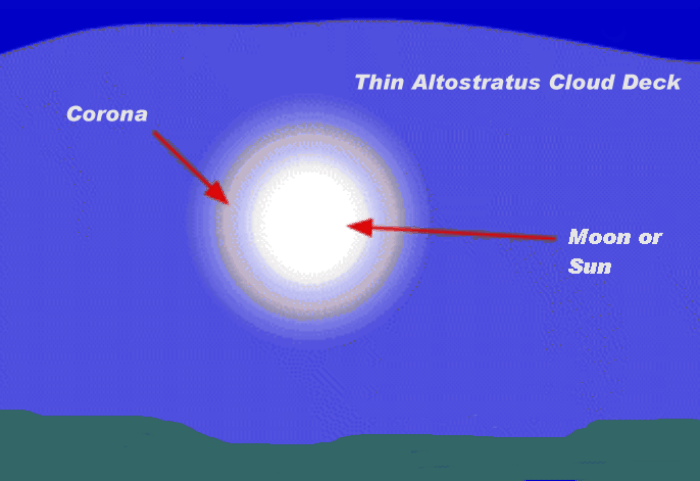 Bishop’s RingA large and faint bluish aureole surrounding the sun with faint yellow and red outer rings has been called a Bishop's ring after Rev. Sereno Bishop of Honolulu, Hawaii who first described the phenomena in 1883 (5 September), several days after the eruption of Krakatoa on 27 August: “Let me draw your special attention to the very strange corona or halo that extends about 20 to 30 degrees away from the sun. It could be seen here every day, and the whole day long. A whitish veil with a shade of pink and violet or purple shadow in front of the blue background. I don‘t know any other report on such a corona. It is a hardly remarkable object.” While Bishop gave the first complete description of the phenomenon, The Japan Gazette published its first observation on 30August 1883, calling the ring a “faint halo” around the sun. (Note that the Bishop’s ring, like all coronae, are reddish on the outside, while a halo is reddish on the inside.) Today, the Bishop’s ring is defined to have an inner aureole of white or bluish white bounded by an outer ring of reddish, brownish or purple coloration. The area enclosed by the rings, which is usually large — a radius of about 28 degrees, is distinctly brighter than its surroundings. 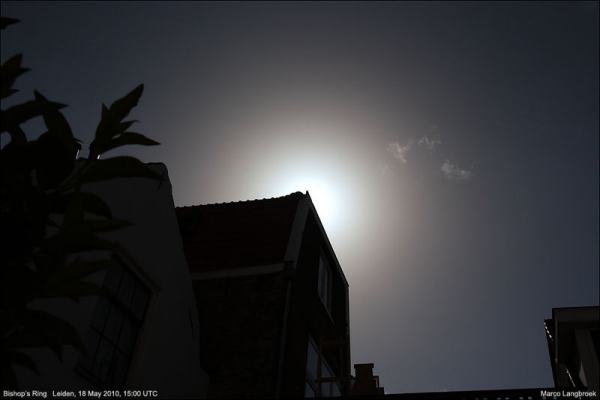 Bishop's Ring around the sun due to volcanic ash of the Iceland Eyjafjallajökull volcano |
|||||||||||||||||||||||||||||||||||
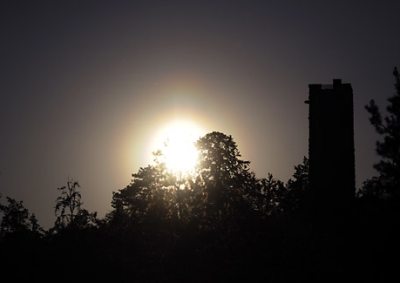 |
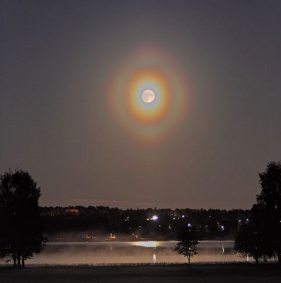 |
Pollen Corona - Schelklingen, Germany |
Lunar Pollen Corona - Vallentuna, Sweden |
I have witnessed such a “pollen storm” here in central British Columbia when strong winds lifted billions of pollen grains from the pine, birch and spruce trees covering the mountainsides and valley in the spring. Since the pollens are of similar size, they can form distinct corona when the pollen cloud moves in between the sun/moon and viewer.
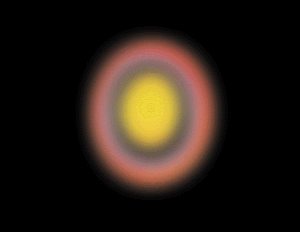 |
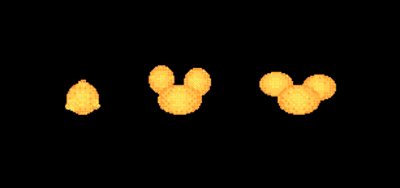 |
Pollen Corona - Finland |
Birch, pine and spruce pollen grains. |
Pollen corona are usually large and rather diffuse, and may be elongated or have bright patches on the rings due to the pollen’s non-spherical shape (such as the one above) and their tendency to orient themselves uniformly in the wind.
An extremely striking and beautiful cousin of the coronae is called irisation. It does not ring the light source like the coronae, but forms in patches at larger angular distances from the sun or moon. The colors frequently are mixed together and are very brilliant, rather than banded like in a corona or halo, and resemble mother-of-pearl. In some situations, however, the colors may show distinct banding.
Irisation, sometimes called iridescence, produces very colorful bands and may be confused by some viewers to be a rainbow or halo. Iridescent colors, like on an oil-slick, or metallic hues characterize the phenomena. They are often pastel-hued with predominance in the pink, purple and light green shades, though shades of deeper blue and red may also be seen. The most common cloud types to show bands of irisation are altocumulus lenticularis, cirrocumulus and occasionally fractocumulus.
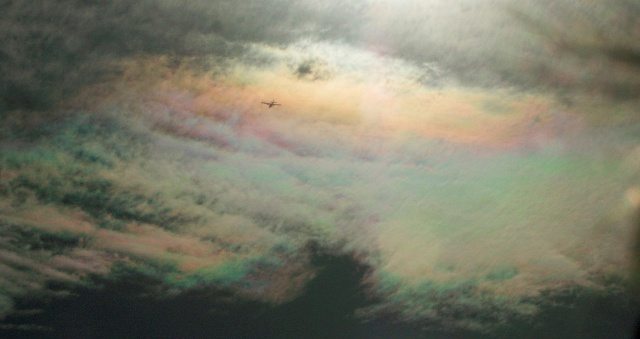 |
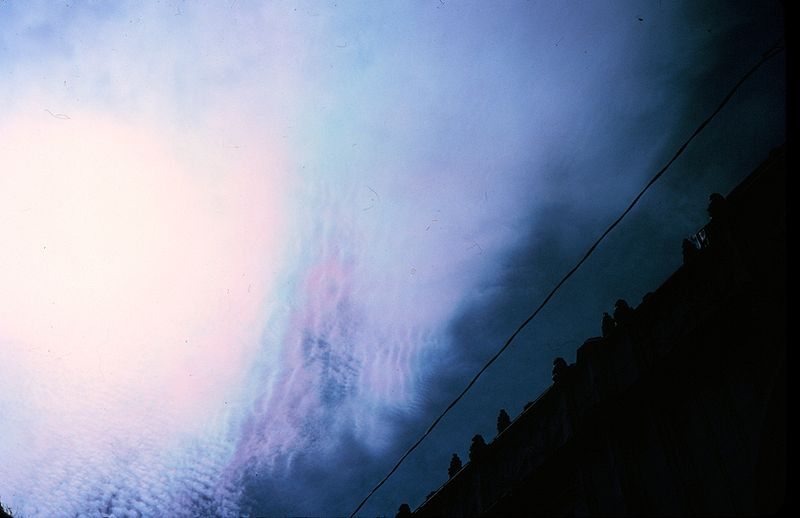 |
Irisation in a cloud produces very colorful bands |
Irisation bands in super-cooled cloud |
Irisation bands usually arise some distance from the sun/moon, as much as 45 degree off the light source. The variety of hues likely derives from the mixing of several refraction bands caused by very small droplets (in the micrometre range) of a uniform size. Close to the sun/moon (within 10 degrees or so), irisation results from diffraction like a corona. But past 10 degrees, constructive and destructive interference of the different colored light wave bands appears to be the predominant factor in producing the effect.
The small size of droplet — at the extreme low end of the cloud droplet size distribution — and uniformity of droplet sizes required for irisation appears to make this phenomenon more rare than coronae (or perhaps we just aren’t looking close enough), which is unfortunate given its beauty.
 |
To Purchase Notecard, |
Now Available! Order Today! | |
 |
 |
Now |
The BC Weather Book: |


